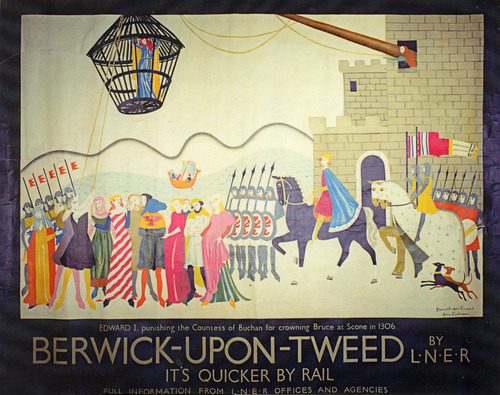A famous episode in the history of Berwick Castle is the tale of the Countess of Buchan being suspended in a cage outside the walls of Berwick Castle.

Railway poster by Doris Zinkeisen, showing the Countess of Buchan.
This episode stems from the Scottish interregnum and the later crowning of Robert Bruce (grandson of the Bruce who claimed the throne in the Great Cause) in March 1306. The crowning of the Scottish monarch was traditionally performed by the head of the Clan McDuff at Scone. However, John Comyn, Earl of Buchan, who should have had this privelige, had sided with the English. Instead, his wife Isobella, the Countess of Buchan (and more importantly, a McDuff) came to Scone to perform the ceremony. She arrived a day after Bruce had been crowned but gave it the McDuff endorsement, without which, some felt the ceremony would be invalid.
Bruce was defeated at the Battle of Methven in June 1306, so he sent Isabella and his female relatives north, but they were betrayed to the English by the Earl of Ross. Edward I ordered her to be sent to Berwick supposedly with these instructions:
“Let her be closely confined in an abode of stone and iron made in the shape of a cross, and let her be hung up out of doors in the open air at Berwick, that both in life and after her death, she may be a spectacle and eternal reproach to travellers.”
What the records of the castle actually say is.
“…he should have made in one of the towers of the castle of that place, in the place which shall seem to him most suitable for this, a cage of strong wooden laths, barred and well reinforced with iron, in which he is to place the Countess of Buchan, and that he should have her so well and surely guarded in that cage that she can in no way leave it. And that he have appointed one or two women of Berwick town, who are to be English and under no suspicion, to serve the Countess with food and drink and other things which they will carry to her in her dwelling, and that he have her so well and closely guarded in the cage that she speaks to no-one, neither man nor woman, who is of the Scottish nation and that no-one else is to approach her except only the woman or women who will be appointed to this, and those who have the custody of her. And that the cage be so made that the Countess may have there the convenience of a privy, but that this be so well and surely arranged that there may be no risk to the keeping of the Countess….”
It was certainly true that she should have the humiliation of being seen in this cage by English visitors but she was held for four years before being released on condition to the Carmelite Friars whose house was in the Palace Green area. She would not have survived anything like that long if suspended outside. Like many stories today, there was more than an element of propaganda put about by both sides.